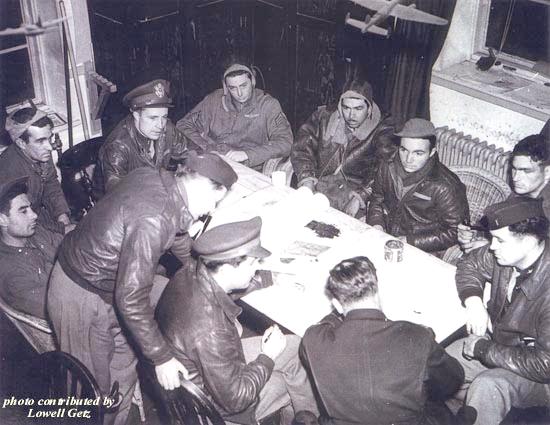

Debriefing after a mission
The men in the picture, from the far right, counterclockwise around the table:
2nd Lt. John A. Coen, Pilot; S/Sgt. Louis T. McLane, Tail Gunner; S/Sgt. Paul E. Kyes, Waist Gunner; T/Sgt. John C. Strozzi, Flight Engineer, Top Turret Gunner; Sgt. Edward F. Simon, Waist Gunner; 2nd Lt. David F. Gladhart, Co-pilot; S/Sgt Francis E. Byrne, Ball Turret Gunner; Sgt. Domenic A. Caruso, Radio Operator; 2nd Lt. John W. Butler, Bombardier; 2nd Lt. Harold A. Davidson, Navigator; unidentified debriefing officer.
Photo contributed by Lowell Getz
Description of photo above by Lowell Getz:
This is a photo of the Coen Crew. Below is the text of the account of the crew.
I traced down all the family members of the crew in order to verify the men in the photo. It was my understanding at that time that your uncle was sending the notebook to Coen's brother. I did not follow up to ensure he had done so. Do you still have the notebook? I can check and see if his brother is still alive. Unfortunately, we most likely cannot get in touch with most of the other family members. Some have died and most still alive did not want to talk about their brothers.
Note that one of te crewmen in this photo did not fly the mission of 28 March (but was also killed in action later).
The picture on the opposing page graphically depicts the emotions of crewmen when it finally came home to them what they had experienced. More than any word can describe, the looks on the faces of these men communicate to us what bomber crews of that time endured. Accordingly, I dedicate this book to the crew in the photograph. The picture is of 2nd Lt. John A. Coen and his crew, taken at debriefing on 22 March 1943, following a mission to the port of Wilhelmshaven. There they took part in an attack on the German pocket battleship, Admiral Sheer, and other port installations. The German defense, both intensity of anti-aircraft fire over the target and attacks by fighters, was among the most aggressive the 91st Bomb Group had experienced up to then. Almost all bombers received battle damage. For most of the men in the picture, this was only their second mission.
Lt. Coen and his original crew arrived at Bassingbourn in early February. Lt Coen flew five missions as a co-pilot to gain combat experience on 14, 16 26, and 27 February and on 6 March. On 4 March, most of his crew was sent out with an experienced pilot, 1st Lt. Harold H. Henderson, along with an experienced flight engineer and waist gunner. They were shot down, with only the flight engineer, T/Sgt. Randle E. Nettles, surviving to become a POW. Lt. Coen began flying as a first pilot on 8 March. Since his crew was lost, he was assigned a crew made up mainly of crewmen from the 92nd Bomb Group on detached assignment with the 91st Bomb Group. The crew included his original flight engineer, T/Sgt. Samuel L. Williams, and waist gunner Sgt. Ben W. Billingsley. Lt. Anderson was flying his combat orientation missions. There was a shortage of flight crews at that time. Lt. Anderson's crew was assigned to Lt. Coen, now an experienced pilot, to fly until Lt. Anderson was ready to take them out himself.
On the 22nd of March, the day the above picture was taken, Lt. Coen's previous crew, composed mainly of 92nd crewmen, as well as Sgts. Williams and Billingsley, was taken out by Cpt. Hascall C. McClellan, the 324th Operations Officer. Cpt. McClellan's plane went down, carrying the entire crew to the bottom of the North Sea. The crewmen in this picture most likely had just learned of the fate of their fellow crewmen.
For the next mission, 28 March, 2nd Lt. Caryll D. Nobbs replaced Lt. Gladhart as co-pilot and S/Sgt. James M. Bechtel replaced Sgt. Simon. Lt. Coen's plane went down on the 28th, six days after this picture was taken. All ten crewmen aboard were killed. Sgt. Simon was killed in action on 22 June 1943. Lt. Gladhart was severely wounded in the left upper forearm by 20 mm cannon fire on 21 May but eventually recovered to resume flying on 16 July. Lt. Gladhart completed his 25-mission tour, the only crewman in the photograph to survive the war.